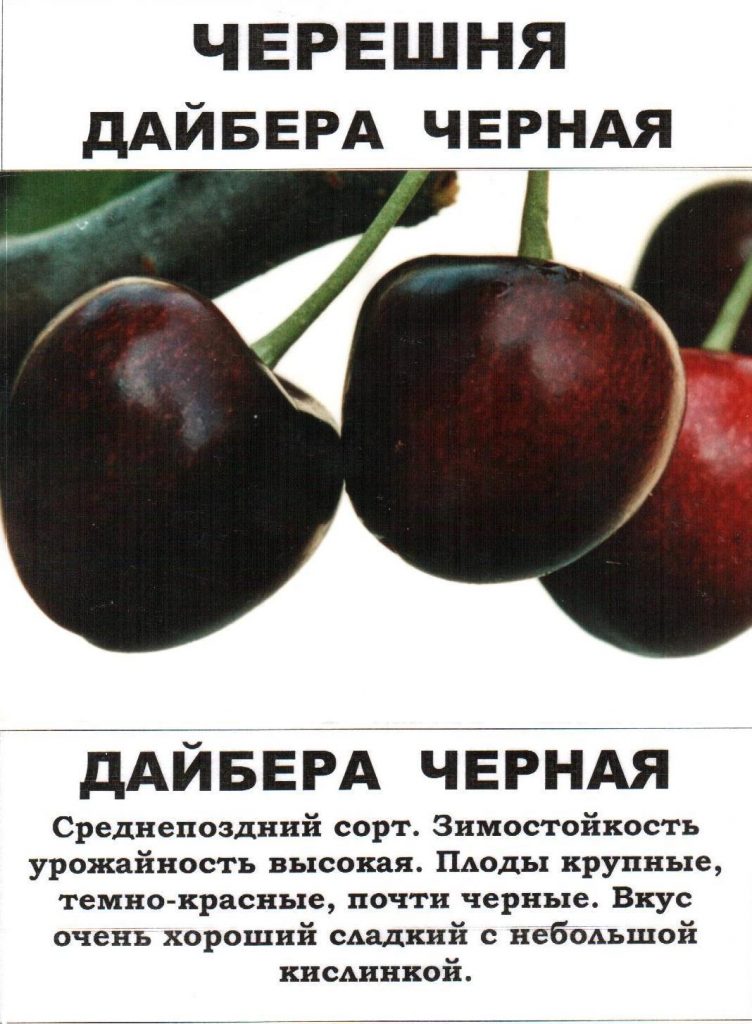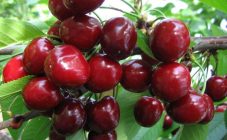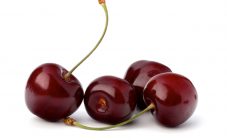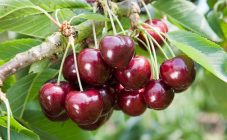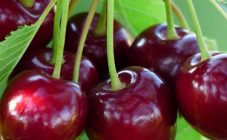Content:
The Diaber cherry is a large-fruited dessert variety that has long been known to domestic gardeners and gardeners. The berries are distinguished by a pronounced sweet taste, contain a large amount of vitamins, and are suitable for fresh consumption and conservation. The variety is grown in the south, does not survive harsh winters and rainy weather. Provided the correct cultivation technique is used, the crop will bring a rich harvest.
Variety history
This variety of cherries was not bred on purpose, but appeared due to accidental pollination. The homeland of the Diaber black cherry variety is Crimea. The official date of birth of the culture is considered to be 1862. The culture was named after the name of the gardener, who first discovered the variety and made a detailed description of it. This variety of sweet cherries was included in the State Register after the war in the late 1940s.
Cherry was zoned in the North Caucasus and in the Lower Volga region. The official name of the variety sounds like A. Dyber Black cherry, but the people often use the abbreviated names Dyber, Black. Sometimes this variety is called the Crimean cherry.
Dyber black cherry: description
Frost resistance
This garden tree does not tolerate frost very well, therefore it is not suitable for growing in the northern regions of Russia. When the frost reaches -24 ° C, then all flower buds die. If the temperature drops below -30 ° C, the branches, trunk and shoots of the cherry freeze. Irreversible changes take place, they turn black and die.
Yield
The Daibera cherry is a large tree with a spreading crown, the berries are large, so the yield is high. The younger the plant, the greater the yield and vice versa.
With proper cultivation techniques, up to 90 kg of fruits can be harvested from one tree per season. The plant begins to bear fruit after 4 years after the seedling has been planted in the open ground. The variety belongs to the mid-season, amicable ripening of berries begins in the third decade of June - the first decade of July.
Tree options
You can recognize Diber cherries by the following characteristics:
- tree height up to 6 m;
- fruit weight 6-7 g;
- the taste of berries is pronounced, sweet with a slight hint of acid;
- fruit color is dark-burgundy, close to black;
- erect shoots of brown-green color with inflorescences, each of which has 2-3 flowers;
- the shape of the crown is round, wide;
- the shape of the leaves is oval, slightly elongated, pointed.
The crown of the tree is branched, each shoot has a large number of leaves.
Pollination
Flowering begins in the last decade of March (in the southern regions) or in the first decade of April (in the more northern regions). The plant is covered with a large number of large white flowers. This is a self-fertile crop, therefore, to get a lot of berries, you need to plant pollinating varieties on the site. The following varieties of cherries are suitable for this purpose:
- Zhabule;
- Gedelfinger;
- Gold;
- Black Eagle.
Pest and disease resistance
The sweet cherry variety is characterized by weak immunity to fungal and bacterial diseases, so prevention should be carried out. Like other varieties bred in the first half of the 20th century, Dyber's cherry often suffers from fruit rot and viral mosaics (another name for this disease is leaf spot). If the spring is wet and windy with a lot of rainfall, fungal diseases can significantly reduce yields.
The main pests are aphids and a weevil beetle. To combat them, the old, time-tested Chlorophos and Karbofos are considered the most effective means.
Landing
The land for planting should be sufficiently moist, and the place should be open and sunny. The culture grows well in calm places on a land rich in nutrients. The soil structure should not be heavy. The roots go about 2 m deep, so you should not plant a tree where groundwater is high.
Landing is carried out as follows:
- The seedling is soaked in water for 2 hours.
- A support is installed in the pit for planting a seedling.
- A small tubercle is formed in the center, on which the seedling is installed and tied to a support.
- Sprinkle and tamp the soil.
- Water and mulch.
Care
The most important activities for the care of the culture are:
- trimming;
- watering;
- fertilizer;
- pest and disease control.
The crown is formed in 2 tiers. At the bottom there should be up to 9 skeletal branches, at the top - 3 layers. The main stem of an adult cherry must be cut at a distance of 3.5 m, otherwise the tree will actively grow in height and bear fruit worse. In the spring, cut off all branches damaged by frost and died during frost.
If the summer is not very dry, the culture is watered no more than 3-4 times, combining watering with top dressing. You can feed cherries with liquid diluted mullein, granulated urea, ash diluted in water, ready-made fertilizers for fruit trees.
To combat pests and prevent fungal diseases, the plant is sprayed with insecticides and fungicides in early spring, before the buds bloom. You can also use proven folk remedies: infusions of dandelion and tobacco.
Advantages and disadvantages
Experienced summer residents speak well of the Dyber cherry and note the following advantages of this culture:
- high productivity;
- berries retain their presentation for a long time, have high taste, are well stored;
- the fruits ripen amicably, so it is very convenient to collect them;
- cherry blossoms beautifully, so it will look spectacular in landscape design.
However, it should be noted that all the advantages of the variety described above are relevant only if the plant is grown in a suitable region for it, on fertile soil rich in nutrients.
Along with the important advantages of the variety, gardeners also note the disadvantages of the Diaber cherry. Here are the main ones:
- berries are often affected by fungus, and leaves by viruses;
- because of the bright color and sweet taste of the fruit, this variety is especially attractive to blackbirds and, if you do not worry about saving, you can easily lose most of the berries;
- the plant does not tolerate drought and frost;
- the tree has a dense branched crown, so frequent pruning is necessary.
Also, the disadvantages include the fact that cherries need to be fed at least 4 times per season, while other varieties usually need 2-3 dressings.
Dyber's cherry is an old, time-tested variety. If you take proper care of the tree, it will certainly give a good harvest and will beautify any orchard.



